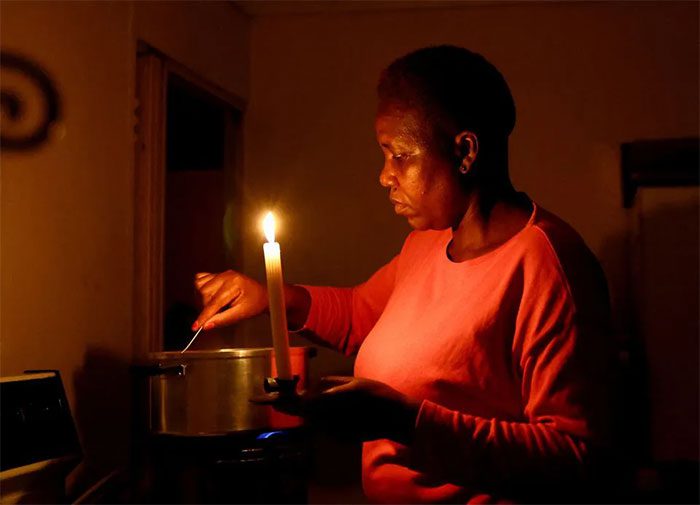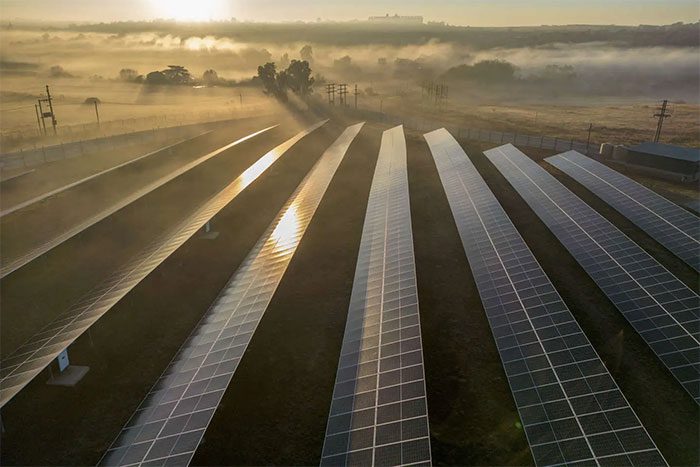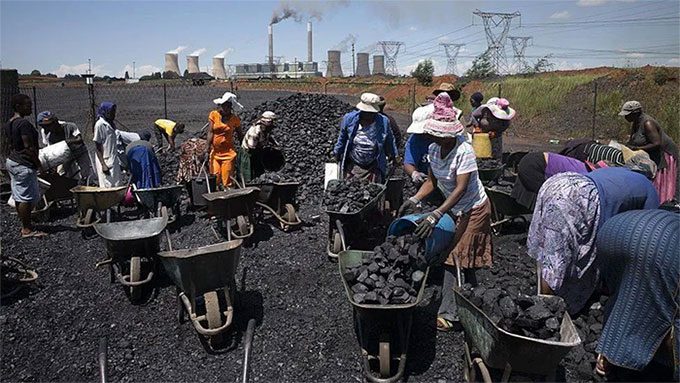This continent has abundant natural gas reserves and a rich underground layer of materials essential for producing batteries, engines, and solar panels.
The French newspaper Le Monde reports that an American refrigerator (consuming about 640 kWh annually) uses 3.5 times the total annual electricity consumption of an average African. This refrigerator is typically manufactured in South Korea or Turkey, made from shiny chrome, featuring two doors and an ice compartment.
Moreover, 590 million people on this continent do not have access to any electricity! Three-quarters of African companies are facing frequent power shortages.

Maria Modiba cooking by candlelight during a frequent power outage from Eskom, South Africa’s power company, in Soweto on November 11, 2022. Photo: REUTERS/Siphiwe Sibeko/File Photo
Paradoxically, Africa is the best-equipped continent when it comes to energy. With its natural gas reserves, sunlight capable of providing abundant electricity, including hydrogen production for export, and a rich underground layer of materials essential for producing batteries, engines, and solar panels…
Renewable, sustainable energy is the foundation for Africa’s future. It is projected that by 2050, this continent will be home to 2 billion people, and two-fifths of the world’s children will be born here.
Meeting their demand with modern, sustainable energy sources—for consumption and production—will be essential for social welfare and economic development. This is particularly critical in a continent that has 33 of the 47 least developed countries in the world (according to UN classification) and where less than half of the population has access to electricity.
Africa Rich in Renewable Energy
The African continent is rich in renewable energy sources, although many of them remain underutilized to this day.
In a recent report, the International Renewable Energy Agency (IRENA) and the African Development Bank (AfDB) estimated that the technical potential for solar photovoltaic (PV) in Africa is 7,900 GW, indicating that Africa possesses some of the largest solar power potential in the world.

Solar power production site, Frankfurt (South Africa), May 11, 2023. (Photo: SHIRAAZ MOHAMED/AFP).
This adds significant potential for hydropower (1,753 GW) and wind energy (461 GW), as well as geothermal and modern biomass energy in various regions of Africa.
Besides being environmentally friendly and often more cost-effective compared to the long-term costs of imported oil and natural gas, renewable energy also has substantial potential to bring significant socio-economic benefits in Africa.
IRENA’s model shows that with appropriate policies, Africa’s systematic transition from fossil fuels to a renewable energy-based system could lead to a GDP increase of 6.4%, adding 3.5% more jobs across the economy throughout the 2020 to 2050 outlook period.
Two of the most notable opportunities related to the energy transition in African countries identified by IRENA and AfDB are financial stability and greater job creation.
For many African energy-importing countries, renewable energy has substantial potential to mitigate vulnerability to external shocks from fossil fuel price volatility.
Renewable energy could also play a central role in job creation, as investments in energy transition technologies generate three times more jobs than fossil fuels for every million dollars spent.
Mobilizing Investment for Clean Energy in Africa
According to IRENA’s analysis, despite the tremendous promise of the energy transition, Africa has only received 2% of global renewable energy investments over the past two decades, with most of these investments flowing into only a few countries. Without rapidly scaling up energy transition investments, the world will not be able to meet global sustainable development and climate commitments.
This is also reflected in a report by the International Energy Agency (IEA), released in 2021 in collaboration with the World Bank and the World Economic Forum, which emphasizes that by 2030, annual clean energy investments in emerging markets and developing economies need to multiply—from under $150 billion in 2021 to over $1 trillion—to put the world on track to achieve net-zero emissions by 2050.
Numerous issues are driving the recent momentum for the energy transition. These include energy poverty, energy security, energy sovereignty, geopolitical interests of various countries, climate change, and recently, the COVID-19 pandemic and its disruptions.
The Risk of Heavy Dependence on Fossil Fuel Exports
The clean energy transition presents significant opportunities for African countries that have traditionally been considered resistant to moving away from fossil fuels. Many African nations still heavily rely on commodity exports, including fossil fuels.
As fossil fuels remain one of Africa’s largest export commodities, many hydrocarbon-exporting countries may face challenging socio-economic issues if they miss the opportunity to diversify their current economies.

Fossil fuels remain one of Africa’s largest export commodities… (Photo: BBC)
The renewable energy sector also offers greater structural benefits for African economies. With commodity exports remaining the primary source of income for many African economies—from agricultural products and textiles to minerals and fossil fuels—renewable energy technologies related to the energy transition will fundamentally benefit these economies.
Local supply chains for renewable energy and energy-saving technologies can help diversify economies and create the aforementioned jobs across various fields—from installation and maintenance to auditing and policy design.
Ultimately, renewable energy will play a crucial role in bridging Africa’s energy access gap, which remains a significant barrier to promoting socio-economic and human development across the continent.
Access to adequate, reliable, and affordable energy is a critical determinant for livelihoods, public services including the provision of modern healthcare and education services, agricultural productivity—and consequently, food security, industrial development, and community resilience.


















































